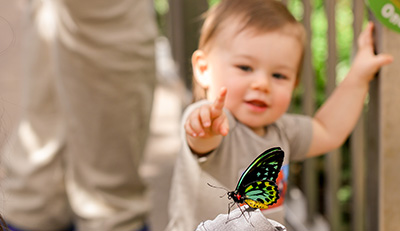We design our spaces to go above and beyond
Our designers and engineers are busy creating spaces that do more than meet the eye. Our spaces are designed to build curiosity muscles, encourage exploration, and bring a smile to everyone’s face.
The Museum of Natural Curiosity is a LEED-certified, highly-efficient green building. That means our certification meets the highest standards for energy and water use, indoor environmental quality, materials used in construction, and the building’s effect on the site. Inside the museum, you’ll find more than 500 interactive exhibits assembled in a way that gives children unlimited opportunities to explore, discover and play.
The museum is designed to stimulate learning and cultivate curiosity through exploratory play. Kids climb through the Rainforest to find hidden chambers or play drums in Kidopolis. They get blown away by the tornado wind tunnel in Waterworks or fly down the zipline at the Discovery Garden. Everything they do helps them ask and answer that wonderfully curious question – “Why?”

When your child walks through our doors at the Butterfly Biosphere, they’ll find the largest butterfly conservatory in the US. They can stand in the butterfly habitat and gaze at over a thousand butterflies that arrive here from forests and jungles all over the world.
Not only will they see hundreds of butterflies, but if they are curious about creepy crawlers, they can explore our insectarium. Walking sticks, big hairy spiders, small scary arachnids, ant colonies, cockroaches of all shapes and sizes, and dozens of other creatures can pique their curiosity.
They can visit the Costa Rica climber and feel what it is like to be a bug in a jungle or stop by one of our “hold a critter” shows where one of our creepy crawly friends can get up close and personal.

When your child comes to our Mountain America Museum of Ancient Life, they travel back in time and explore what life was like over 65 million years ago! This dinosaur adventure contains one of the world’s largest displays of mounted dinosaurs.
Kids can wander through time, oceans, and deserts. They can explore more than 50 hands-on exhibits, like the Erosion Table and the Quarry Dig, making interacting with pre-history cooler than ever before. They can even watch our paleontologist and volunteers unearth a 150-million-year-old Barosaurus.
The space itself is designed to help your child feel like an explorer, seeking the next new discovery around every turn. It’s a place where the past comes alive.

Ashton Gardens is a 50-acre stately garden full of diverse plant life, smartly placed in the center of Lehi, Utah. Residents come often for a respite, to reconnect with nature and explore plant life at its best. Inside the gardens, kids of all ages discover the largest manmade waterfall in America, learn about the various flora, and enjoy an oasis in the Utah desert.
When you and your family visit in April, you’ll discover the world-renowned Tulip Festival. As spring begins in the gardens, nearly 300,000 tulips start to pop up and create a blanket of color unlike any other tulip festival in the US. Take your best selfie, enjoy a picnic, or just marvel in the wonders of the natural world.
During the summer months, the gardens are the perfect place to attend concerts, watch some outdoor movies, and encounter life-sized, animatronic dinosaurs. And, every holiday season, the gardens are home to Luminaria—a light show extravaganza like no other in the world. All of these experiences and more are only available at the Ashton Gardens.

Curiosity Farms is designed for kids to discover where their food comes from, explore the wonders of animal life, and get hands-on with goats, ponies, and other animals as they enter a real working farm.
From breeding to feeding and planting to harvesting, kids actively help run the farm. They get dirt under their fingernails, care for a pony, and get nose-to-nose with a friendly cow. The farm was designed to promote the well-being of animals and kids.
By interacting with animals, kids can foster curiosity about and connect with the natural world. They learn about the natural cycles of life such as climate, soils, propagation, nutrition, genetics, and the sciences of indigenous farming and sustainable agriculture. They can make friends with their favorite four-legged creature and can leave with a greater appreciation for agriculture.




